Feynman Path Integrals in Quantum Mechanics
Feynman Path Integrals in Quantum Mechanics
Feynman Path Integrals in Quantum Mechanics
- No tags were found...
Create successful ePaper yourself
Turn your PDF publications into a flip-book with our unique Google optimized e-Paper software.
<strong>Feynman</strong> <strong>Path</strong> <strong>Integrals</strong> <strong>in</strong> <strong>Quantum</strong> <strong>Mechanics</strong>Christian EgliOctober 1, 2004AbstractThis text is written as a report to the sem<strong>in</strong>ar course <strong>in</strong> theoretical physics atKTH, Stockholm. The idea of this work is to show <strong>Quantum</strong> <strong>Mechanics</strong> from adifferent perspective: based on the <strong>Path</strong> Integral formalism, orig<strong>in</strong>ally worked outby R.P. <strong>Feynman</strong> <strong>in</strong> 1948. The mathematical equivalence to the familiar formulationshall be shown. In addition some other applications and methods of <strong>Path</strong> <strong>Integrals</strong><strong>in</strong> non-relativistic <strong>Quantum</strong> <strong>Mechanics</strong> are discussed.Contents1 Introduction 22 The <strong>Path</strong> Integral Formulation of <strong>Quantum</strong> <strong>Mechanics</strong> 22.1 Probability and Probability Amplitude . . . . . . . . . . . . . . . . . . . . 22.2 Probability Amplitude for a <strong>Path</strong> . . . . . . . . . . . . . . . . . . . . . . . 22.3 The <strong>Path</strong> Integral and the Wave Function . . . . . . . . . . . . . . . . . . 32.3.1 The Free Particle . . . . . . . . . . . . . . . . . . . . . . . . . . . . 42.4 Classical Limit . . . . . . . . . . . . . . . . . . . . . . . . . . . . . . . . . 43 Equivalence to Schröd<strong>in</strong>gers Operator Notation 43.1 Derivation of the Schröd<strong>in</strong>ger Equation . . . . . . . . . . . . . . . . . . . 43.2 Schröd<strong>in</strong>ger Equation for the Kernel . . . . . . . . . . . . . . . . . . . . . 54 Pertubation Theory 55 <strong>Path</strong> <strong>Integrals</strong> <strong>in</strong> Phase Space 66 <strong>Path</strong> <strong>Integrals</strong> and Topology 76.1 The Aharonov-Bohm effect . . . . . . . . . . . . . . . . . . . . . . . . . . 76.2 <strong>Path</strong> <strong>Integrals</strong> with Topological Constra<strong>in</strong>ts . . . . . . . . . . . . . . . . . 77 Statistical <strong>Mechanics</strong> 88 Summary 81
1 IntroductionThe standard formulations of <strong>Quantum</strong> <strong>Mechanics</strong> were developed by Schröd<strong>in</strong>ger, Heisenbergand others <strong>in</strong> the 1920s. Already 1933 Dirac published a paper where he suggestsexp(iS/¯h) to correspond to the propagator, where S is the classical action. <strong>Feynman</strong>developed this idea, concern<strong>in</strong>g other paths than only the classical one and publisheda third complete formulation of <strong>Quantum</strong> <strong>Mechanics</strong> <strong>in</strong> 1948 ([1]). As we will see, thisformulation provides a much more <strong>in</strong>tuitive <strong>in</strong>troduction to the quantum theory. First ofall we will have to state the fundamental concepts of <strong>Quantum</strong> <strong>Mechanics</strong>. S<strong>in</strong>ce they arewell known to the reader I will do that very shortly but <strong>in</strong> a way which is useful for thedevelopment of the theory <strong>in</strong> later sections.2 The <strong>Path</strong> Integral Formulation of <strong>Quantum</strong> <strong>Mechanics</strong>The goal of this section is to <strong>in</strong>troduce <strong>Quantum</strong> <strong>Mechanics</strong> <strong>in</strong> a completely different wayfrom how it is usually done <strong>in</strong> textbooks.2.1 Probability and Probability AmplitudeLet’s start with the famous imag<strong>in</strong>ary double-slit experiment: We have an electron source<strong>in</strong> some po<strong>in</strong>t A, a screen B with two holes through which the electrons might pass, anda detector plane C. We def<strong>in</strong>e P 1 (x) as the probability that, if we close hole number2, an electron is detected at the position x <strong>in</strong> C. Analogously for P 2 (x). It is a wellknown experimental fact that P (x), the probability to arrive at x with both holes open,is not equal to (P 1 (x) + P 2 (x)) as long as we do not detect which hole the electron hasgone through. We can state a correct law for P (x) mathematically as follows: there arecomplex numbers Φ 1 and Φ 2 such thatP = |Φ| 2 , where Φ = Φ 1 + Φ 2 , P 1 = |Φ 1 | 2 , P 2 = |Φ 2 | 2 (1)We call Φ(x) the probability amplitude for arrival at x.2.2 Probability Amplitude for a <strong>Path</strong>Instead of only hav<strong>in</strong>g one screen and two holes as <strong>in</strong> 2.1, we can th<strong>in</strong>k about <strong>in</strong>sert<strong>in</strong>gmore screens and hav<strong>in</strong>g several holes <strong>in</strong> each screen. The number of possible paths (eachof which will have some ”partial” amplitude Φ i (x)) from A to some po<strong>in</strong>t x on C <strong>in</strong>creases.The total amplitude Φ(x) for an electron start<strong>in</strong>g <strong>in</strong> A to reach this po<strong>in</strong>t x on C <strong>in</strong> acerta<strong>in</strong> time T will be the sum of all partial amplitudes Φ i (x). To formulate this moreformally, we shall limit ourselves to a one-dimensional problem. The generalization toseveral dimensions is obvious.We def<strong>in</strong>e P (b, a) as the probability to go from a po<strong>in</strong>t x a at the time t a to the po<strong>in</strong>t x b att b . We now know that we can write the probability P (b, a) = |K(b, a)| 2 of an amplitudeK(b, a) to go from a to b. This amplitude is the sum of all the partial amplitudes 1 , onefor each possible path from (x a , t a ) to (x b , t b ). We now write the partial amplitudes asΦ[x(t)].∑K(b, a) =Φ[x(t)] (2)all paths from a to bThe question is how each path x(t) contributes to the total amplitude. It is so to speakthe central po<strong>in</strong>t <strong>in</strong> the <strong>Path</strong> Integral theory of <strong>Quantum</strong> <strong>Mechanics</strong> that <strong>Feynman</strong> postulates2 : The paths contribute equally <strong>in</strong> magnitude, but the phase of their contribution1 This corresponds to <strong>Feynman</strong>s postulate I <strong>in</strong> [1].2 Postulate II <strong>in</strong> [1]2
is the classical action S <strong>in</strong> units of the quantum of action ¯h , i.e.where the classical action S is def<strong>in</strong>ed by:Φ[x(t)] = const e (i/¯h)S[x(t)] (3)S[x(t)] =∫ tb2.3 The <strong>Path</strong> Integral and the Wave Functiont aL(ẋ, x, t) dt (4)The ma<strong>in</strong> question is, how to perform the sum over all paths. We divide the time <strong>in</strong>terval(t b − t a ) <strong>in</strong> N <strong>in</strong>tervals of length ɛ. For each path x(t) we can write x i = x(t i ) [Nɛ =t b − t a , ɛ = t i+1 − t i , t 0 = t a , t N = t b , x 0 = x a , x N = x b ] and get as a result for”the sum over all paths”:1K(b, a) = limɛ→0 A∫ ∫∫· · ·e (i/¯h)S[b,a] dx 1Adx 2A · · · dx N−1Awith some normalization factor A, which we need for the convergence of the whole expression.Its value shall be determ<strong>in</strong>ed later (but it will naturally depend on ɛ). 3K(b, a) is called the Kernel of the motion. We will denote it asK(b, a) =∫ ba(5)e (i/¯h)S[x(t)] Dx(t) (6)and call it <strong>in</strong> this notation the configuration space path <strong>in</strong>tegral or <strong>Feynman</strong> path <strong>in</strong>tegral.For K(b, a) there is a rule for comb<strong>in</strong><strong>in</strong>g amplitudes for events occur<strong>in</strong>g <strong>in</strong> succession<strong>in</strong> time:∫K(b, a) = K(b, c)K(c, a)dx c , if t a < t c < t b (7)x c[this rule follows from the fact S[b, a] = S[b, c] + S[c, a] (which is true from the def<strong>in</strong>itionof the action. It holds for any po<strong>in</strong>t c ly<strong>in</strong>g on the path from a to b). To prove (7), simply<strong>in</strong>sert the relation above <strong>in</strong> Eq. (6).]This procedure can be extended from only hav<strong>in</strong>g one to N −1 <strong>in</strong>termediate steps betweena and b. We get the expression∫ ∫K(b, a) = · · K(b, N−1)K(N−1, N−2) · · · K(i+1, i) · · · K(1, a)dx 1 dx 2 · · · dx N−1 .∫x 1 x 2·x N−1(8)If we compare now to (5), we f<strong>in</strong>d for the kernel for two po<strong>in</strong>ts separated by an <strong>in</strong>f<strong>in</strong>itesimaltime <strong>in</strong>terval ɛ, which is correct to first order 4 <strong>in</strong> ɛ:K(i + 1, i) = 1 [ ( iɛA exp ¯h L xi+1 − x i, x i+1 + x i, t i+1 + t iɛ 2 2Deal<strong>in</strong>g with <strong>Quantum</strong> <strong>Mechanics</strong> we are however more used to have some wave functionΨ(x, t) rather than the kernel 5 . We can derive a expression for Ψ(x, t) from (7):Ψ(x 2 , t 2 ) =∫ ∞−∞)](9)K(x 2 , t 2 ; x 1 , t 1 )Ψ(x 1 , t 1 )dx 1 (10)In physical terms: The total amplitude to arrive at (x 2 , t 2 ) is equal the sum over allpossible values of x 1 of the amplitude to be at x 1 (at a fixed time t 1 ) multiplyed by theamplitude to go from 1 to 2.3 To be precise: In (5) the action is def<strong>in</strong>ed by S = P i S(x i+1, x i ), where S(x i+1 , x i ) =m<strong>in</strong> R t i+1t iL(ẋ(t), x(t))dx, which obviously corresponds to the classical action on the <strong>in</strong>terval (x i , x i+1 ).4 Detailed calculations and <strong>Feynman</strong>s own ”justification” are found <strong>in</strong> [1]5 Actually the kernel K(x 2 , t 2 ; x 1 , t 1 ) = Ψ(x 2 , t 2 ) is a wave function as well.3
2.3.1 The Free ParticleIt might be good to see a kernel once <strong>in</strong> its very explicit form. Maybe it will even behelpfull <strong>in</strong> later sections. For the free particle case we simply have to put L = mẋ 2 /2 <strong>in</strong>(9) and <strong>in</strong>sert this <strong>in</strong> (8). I do not write down the calculations, s<strong>in</strong>ce it is basically solv<strong>in</strong>ga set of Gaussian <strong>in</strong>tegrals and can certa<strong>in</strong>ly be found <strong>in</strong> any of the references.[ ] −1/2 2πi¯h(tb − t a )K(b, a) =exp im(x b − x a ) 2m2¯h(t b − t a )(11)2.4 Classical LimitIn the classical limit, i.e. when ¯h → 0, only paths that lie very close to the classical onegive significant contribution to the probability amplitude.One can see this <strong>in</strong> the follow<strong>in</strong>g way: Let’s look at any two neighbour<strong>in</strong>g paths x(t) andx ′ (t) which contribute to the path <strong>in</strong>tegral (6). We can write x ′ (t) = x(t) + η(t), withη(t) small. For the action we get:∫S[x ′ (t)] = S[x(t) + η(t)] = S[x(t)] +η(t) δS[x(t)]δx(t) dt + O(η2 ) (12)The contribution of the two paths to the path <strong>in</strong>tegral is:(A = e iS[x(t)]/¯h + e iS[x′ (t)]/¯h ≃ e iS[x(t)]/¯h 1 + exp ī ∫hη(t) δS[x(t)]δx(t) dt ), (13)where we have neglected terms of order η 2 . The phase difference between the contributionsis approximately ¯h −1 ∫ (η(t)δS[x(t)]/δx(t))dt. Even if δS gets very small, <strong>in</strong> the limit¯h → 0 the phase difference is huge and consequently on average destructive <strong>in</strong>terferencebetween neighbour<strong>in</strong>g paths occurs! There is an exception for the classical path. S<strong>in</strong>ceδS at x c (t) vanishes, the action is of the form S[x c + η] = S[x c ] + O(η 2 ) and even for verysmall values of ¯h constructive <strong>in</strong>terference results.3 Equivalence to Schröd<strong>in</strong>gers Operator NotationIn the classical formulation of <strong>Quantum</strong> <strong>Mechanics</strong> the Schröd<strong>in</strong>ger equation is postulated.In this section we will show, that it is possible to derive the Schröd<strong>in</strong>ger equation fromthe postulates made <strong>in</strong> part 2.3.1 Derivation of the Schröd<strong>in</strong>ger EquationLet’s start with Eq. (10) for the wave function. We set t 1 = t and t 2 = t + ɛ and use forthe kernel the expression derived <strong>in</strong> (9). In words, for a short time <strong>in</strong>terval ɛ the actionis approximately ɛ times the lagrangian for this <strong>in</strong>terval. We getΨ(x, t + ɛ) =∫ ∞−∞(1A expɛ ī ( x − yh L ɛ, x + y )), t Ψ(y, t)dy (14)2Observe that this equation is not exact. But it needs only be true to first order to ɛ, s<strong>in</strong>ce(5) still holds 6 ; i.e. we shall derive the Schröd<strong>in</strong>ger equation assum<strong>in</strong>g (14) to be true <strong>in</strong>first order to ɛ. This can be done <strong>in</strong> the follow<strong>in</strong>g way 7 : write the Lagrangian <strong>in</strong> the formL = mẋ 2 /2 − V (x, t) and substitute y = x + η. The <strong>in</strong>tegration over y becoms an <strong>in</strong>tegral6 For a f<strong>in</strong>ite time <strong>in</strong>terval T the number of factors is T/ɛ. If an error of order ɛ 2 is made <strong>in</strong> each factor,the result<strong>in</strong>g error is of order ɛ and vanishes <strong>in</strong> the limit7 Intermediate steps are left out here. The are found <strong>in</strong> [3]4
over η. The result<strong>in</strong>g <strong>in</strong>tegrals are Gaussian and can be solved explicitely. Expand<strong>in</strong>g 8 tofirst order <strong>in</strong> ɛ and second order to η leeds then to the equationΨ + ɛ ∂Ψ∂t = Ψ − iɛ¯h V Ψ − ¯hɛ ∂ 2 Ψ2im ∂x 2 . (15)(15) is true <strong>in</strong> first order to ɛ, if Ψ satisfies [def<strong>in</strong><strong>in</strong>g H = − ¯h22m ∂x+ V ] the differential2Equation−¯h ∂Ψ= HΨ , (16)i ∂twhich is the Schröd<strong>in</strong>ger equation!3.2 Schröd<strong>in</strong>ger Equation for the KernelThe kernel K(2, 1) <strong>in</strong>troduced by (6) is only def<strong>in</strong>ed for t 2 > t 1 . S<strong>in</strong>ce K(2, 1), consideredas a function of the variables 2, is a special wave function it is clear that (16) is satisfied:−¯hi∂Ψ∂t 2K(2, 1) − H 2 K(2, 1) = 0 for t 2 > t 1 (17)Where H 2 acts on the variables 2 only.If we def<strong>in</strong>e K(2, 1) = 0 for t 2 < t 1 , (17) is also valid for t 2 < t 1 but K(2, 1) getsdiscont<strong>in</strong>ous at t 2 = t 1 . One can show, that the kernel satisfies−¯hi∂Ψ∂t 2K(2, 1) − H 2 K(2, 1) = −¯h i δ(x 2 − x 1 )δ(t 2 − t 1 ) (18)Remark:We <strong>in</strong>troduced K(2, 1) as the probability amplitude. Another possibility is to start fromthe usual formulation of <strong>Quantum</strong> <strong>Mechanics</strong>. The kernel can then be def<strong>in</strong>ed as theGreen’s function for the Schröd<strong>in</strong>ger equation. This means: one def<strong>in</strong>es K(2, 1) to bethe solution of Eq. (18). This is equivalent 9 to the follow<strong>in</strong>g def<strong>in</strong>ition <strong>in</strong> the betterknown Dirac representation: K(2, 1) = 〈x 2 |Û(t)|x 1〉, where Û(t) = e−iĤt/¯h as long as theHamiltonian is time-<strong>in</strong>dependent.F<strong>in</strong>ally we remark that K(2, 1) only depends on the time difference (t 2 − t 1 ) [as longas the Hamiltonian is time-<strong>in</strong>dependent].4 Pertubation TheoryThe idea of Pertubation theory <strong>in</strong> the path <strong>in</strong>tegral formulation of <strong>Quantum</strong> <strong>Mechanics</strong>is quite simple. We look at a particle mov<strong>in</strong>g <strong>in</strong> some potential 10 V (x, t). If we <strong>in</strong>sert (4)<strong>in</strong> (6) and expand the exponential, we getK V (2, 1) = K 0 (2, 1) + K 1 (2, 1) + K 2 (2, 1) + · · · , where (19)∫ 2[ ( ∫ īt2mẋ 2 )]K 0 (2, 1) = exp1 h t 12 dt Dx(t) (20)K 1 (2, 1) = − ī ∫ 2[ ( ∫ īt2mẋ 2 )] ∫ t2exph 1 h t 12 dt V [x(s), s]ds Dx(t) (21)t 1K 2 (2, 1) = − 1 ∫ 2[ ( ∫ īt2mẋ 2 )] [∫ t2] 22¯h 2 exp1 h t 12 dt V [x(s), s]ds Dx(t) (22).8 Demand<strong>in</strong>g this expansion to be true <strong>in</strong> the limit ɛ → 0, the promised condition <strong>in</strong> A appears, with the result A = 2πi¯hɛ 1/2.9mThis follows from ”normal” <strong>Quantum</strong> <strong>Mechanics</strong>. Discussed <strong>in</strong> [4], [5]10 The <strong>in</strong>dex V <strong>in</strong> Eq. (19) shall just symbolize that the particle is mov<strong>in</strong>g <strong>in</strong> some potential V (x, t)t 1∂ 25
K 0 is just the free-particle kernel (11). If we <strong>in</strong>terchange the order of <strong>in</strong>tegration over xand x(t) we get for K 1 :∫ t2K 1 (2, 1) = − ī F (s)ds , where (23)h t 1∫ 2[ ( ∫ īt2mẋ 2 )]F (s) = exp1 h t 12 dt V [x(s), s] Dx(t) (24)This expression F (s) can be <strong>in</strong>terpreted as free propagation from t 1 until some <strong>in</strong>termediatetime s and aga<strong>in</strong> from s until t 2 , only weight<strong>in</strong>g each path with a characteristic factorV [x(s), s]. Consequentely we can write F (s) <strong>in</strong> the formF (s) =∫ ∞−∞and with (23) the pertubation term givesK 1 (2, 1) = − ī h∫ t2∫ ∞t 1K 0 (x 2 , t 2 ; x s , s)V (x s , s)K 0 (x s , s; x 1 , t 1 )dx s (25)−∞K 0 (x 2 , t 2 ; x s , s)V (x s , s)K 0 (x s , s; x 1 , t 1 )dx s ds (26)The <strong>in</strong>terpretation is the follow<strong>in</strong>g: K 0 (2, 1) gives us the amplitude that the particle ismov<strong>in</strong>g all the way from 1 to 2 without be<strong>in</strong>g affected by V (x, t) at all. K 1 (2, 1) is theamplitude that the particle is scattered once at any time s between 1 and 2. K 2 (2, 1)will then be the amplitude to be scattered twice, and so on. This can be developed bysimilar steps as above. A very <strong>in</strong>terest<strong>in</strong>g feature of the kernel K V (2, 1) is that it fulfillsthe follow<strong>in</strong>g <strong>in</strong>tegral equation:K V (2, 1) = K 0 (2, 1) − ī h∫ t2∫ ∞t 1−∞K 0 (x 2 , t 2 ; x s , s)V (x s , s)K V (x s , s; x 1 , t 1 )dx s ds (27)We will not further look at that. It shall just be said, that this has some applications <strong>in</strong>scatter<strong>in</strong>g theory.5 <strong>Path</strong> <strong>Integrals</strong> <strong>in</strong> Phase SpaceAs we have seen <strong>in</strong> the end of 3.2, an equivalent def<strong>in</strong>ition for the kernel is K(2, 1) =〈x 2 |Û(t)|x 1〉. With this def<strong>in</strong>ition and mak<strong>in</strong>g use of Eq. (8) (Divid<strong>in</strong>g (t 1 − t 2 ) <strong>in</strong> N<strong>in</strong>tervals of length ɛ; we then assume Ĥ to be time <strong>in</strong>dependent on such an <strong>in</strong>terval, i.e.K(i, i + 1) = 〈x i |e −iĤɛ/¯h |x i+1 〉) one f<strong>in</strong>ds the follow<strong>in</strong>g expression for K(2, 1) [see [7]]:∫ N−1 ∏∫ N−1)∏ dp jK(2, 1) = lim dx i(ɛɛ→0 2π¯h exp ī N−1∑(p k ẋ k − H(p k , ¯x k )) , (28)hi=1 j=0k=0where ẋ k = 1 ɛ (x k+1 − x k ) and ¯x k = 1 2 (x k + x k+1 ). Similar to (6) we write that asK(b, a) =∫ ba[ īexph∫ tbt a](pẋ − H(p, x))dtDx(t) Dp(t)2π¯h(29)and call it the phase space path <strong>in</strong>tegral.The phase space path <strong>in</strong>tegral is somehow more general than the <strong>Feynman</strong> path <strong>in</strong>tegral.For the case where the Hamiltonian has its standard form (H = p 2 /2m + V (x, t))it is easy to show the equivalence to the configuration space path <strong>in</strong>tegral. One <strong>in</strong>serts 11the standard form of the Hamiltonian <strong>in</strong> (28) (the proper def<strong>in</strong>ition of (29)) and gets (5)by straightforward calculation, which then can be written <strong>in</strong> the form of (6).11 For the explicit calculations look aga<strong>in</strong> <strong>in</strong> [7].6
6 <strong>Path</strong> <strong>Integrals</strong> and Topology6.1 The Aharonov-Bohm effectLet’s ”abuse” the Aharonov-Bohm effect to illustrate a first example of a non-simplyconnectedconfiguration space. Take the double slit experiment from section 2.1 and puta perfectly shielded magnetic flux between the holes. Classically, because of the perfectshields, an electron does not feel any force. Due to the magnetig flux, we have to replacethe Lagrangian L by L ′ :L(ẋ, x) → L ′ (ẋ, x) = L(ẋ, x) − e v · A(x) , where B = ∇ × A (30)c∫ ∫This changes the action S of a path by the amount − e c dt v·A(x) = −ec dtdxdt ·A(x(t)),which is the l<strong>in</strong>e <strong>in</strong>tegral of A taken along the path. For any two paths x 1 (t) and x 2 (t),which go through hole 1 and 2 respectively we get∫∫∮dx · A(x) − dx · A(x) = dx · A(x) = Φ , (31)x 2(t)x 1(t)where Φ is the flux <strong>in</strong>side the closed loop. Note that the value of the <strong>in</strong>tegral does notdepend on the details of x 1 (t) and x 2 (t)! We might write the total amplitude K ′ =K 1 ′ + K 2, ′ where K 1 ′ (K 2) ′ is the sum over all paths through slit 1 (2). K = K 1 + K 2denotes the case, when the magnetic field ist turned off (Φ = 0). We can write for K 1:′∫K 1 ′ = Dx e i(S[x]−(e/c) R dx·A)/¯h = e −ie R 1 dx·A/¯hc K 1 , (32)slit 1where we have pulled out the l<strong>in</strong>e <strong>in</strong>tegral factor s<strong>in</strong>ce it is the same for all paths throughslit 1. Thus for the total amplitude:K ′ = e −ie R 1 dx·A/¯hc K 1 + e −ie R 2 dx·A/¯hc K 2 (33)= e −ie R ( 1 dx·A/¯hc K 1 + e −ie H )dx·A/¯hc K 2 (34)= e −ie R ( )1 dx·A/¯hc K 1 + e −ieΦ/¯hc K 2 (35)The first factor is just an irrelevant overall phase. The <strong>in</strong>terference pattern is determ<strong>in</strong>edby the phase −eΦ/¯hc and can be changed by vary<strong>in</strong>g the magnetic flux.6.2 <strong>Path</strong> <strong>Integrals</strong> with Topological Constra<strong>in</strong>tsThere are many examples for path <strong>in</strong>tegrals for spaces with topological constra<strong>in</strong>ts, suchas a particle <strong>in</strong> a box, on a half-l<strong>in</strong>e or generally <strong>in</strong> a half-space. Here we look at a particleon a cirle. On a circle our coord<strong>in</strong>ate is ϕ, 0 ≤ ϕ ≤ 2π with ϕ = 0 and ϕ = 2π identified.A path <strong>in</strong> this system is a cont<strong>in</strong>uous function ϕ(t) with the identification above. We candivide the set of all paths <strong>in</strong>to subsets of paths with the same w<strong>in</strong>d<strong>in</strong>g number. We cantherefore write (take ¯h = 1 for this section) the kernelK(ϕ 2 , t 2 ; ϕ 1 , t 1 ) =∑e iS[ϕ(t)] =ϕ(t 1)=ϕ 1ϕ(t 2)=ϕ 2∞∑n=−∞∑g n = {ϕ(t)| t 1 ≤ t ≤ t 2 , ϕ(t 1 ) = ϕ 1 , ϕ(t 2 ) = ϕ 2 ,ϕ(t)∈g ne iS[ϕ(t)] , where (36)ϕ(t) is cont<strong>in</strong>uous and has w<strong>in</strong>d<strong>in</strong>g number n} (37)We now assume that each term <strong>in</strong> the sum (36) <strong>in</strong>dividually satisfies the Schröd<strong>in</strong>gerequation 12 . We see that <strong>in</strong> this case∑ ∑A n e iS[ϕ(t)] , A n ∈ C (38)n ϕ∈g n12 A justification for that can be found <strong>in</strong> [5]7
can be a solution for the kernel as well. From periodicity follows the condition A n+1 = e iδ A n ,δ ∈ R. With A 0 = 1 we get A n = e <strong>in</strong>δ and can then write:∞∑K(ϕ 2 , t 2 ; ϕ 1 , t 1 ) = A n K n (ϕ 2 , t 2 ; ϕ 1 , t 1 ), (39)n=−∞where K n (ϕ 2 , t 2 ; ϕ 1 , t 1 ) is the kernel for all paths with n loops. For each K n we can carrythe Lagrangian 13 from S 1 to R and, for a free particle, use 14 (11). Insert<strong>in</strong>g this <strong>in</strong> (39)we obta<strong>in</strong> the kernel for a free particle mov<strong>in</strong>g on a circle:K(ϕ 2 , t 2 ; ϕ 1 , t 1 ) =∞∑n=−∞(I2πi(t 2 − t 1 )7 Statistical <strong>Mechanics</strong>) 1/2exp[<strong>in</strong>δ +]iI2(t 2 − t 1 ) ((ϕ 2 − ϕ 1 ) − 2nπ) 2In this last section we just want to see, how Statistical <strong>Mechanics</strong> and path <strong>in</strong>tegrals<strong>in</strong> <strong>Quantum</strong> <strong>Mechanics</strong> are related. The central object <strong>in</strong> Statistical <strong>Mechanics</strong> is thepartition function. It is def<strong>in</strong>ed by(40)Z := ∑ je −βEj= ∑ j〈j|e −βĤ|j〉 = Tre −βĤ, (41)where β = 1/k B T and E j is the energy of the state |j〉. Recall the alternative def<strong>in</strong>itionfor the kernel: K(x 2 , t 2 ; x 1 , t 1 ) = 〈x 2 |e −iĤ(t2−t1)/¯h |x 1 〉. Let’s see what happens, if wemake the substitution (t 2 − t 1 ) := −iβ¯h, where β is real:K(x 2 , −iβ¯h; x 1 , 0) = 〈x 2 |e −iĤ(−iβ¯h)/¯h |x 1 〉 = 〈x 2 |e −βĤ ∑ j|j〉〈j||x 1 〉 (42)= ∑ je −βEj 〈x 2 |j〉〈j|x 1 〉 = ∑ je −βEj 〈j|x 1 〉〈x 2 |j〉 (43)where we used the completenessrelation ∑ j |j〉〈j| = 1. Putt<strong>in</strong>g x = x 1 = x 2 and <strong>in</strong>tegrat<strong>in</strong>gover x, we get:∫K(x, −iβ¯h; x, 0)dx = ∑ ∫e −βEj 〈j| dx|x〉〈x| |j〉 = Z (44)j } {{ }=1This equation tells us how the propagator evaluated at negative imag<strong>in</strong>ary time isrelated to the partition function! This can be of practical use: It gives us a tool to easilycalculate the partition function of a physical system of which we know the path <strong>in</strong>tegral(kernel).8 SummaryThis was a short <strong>in</strong>troduction <strong>in</strong> the path <strong>in</strong>tegrals <strong>in</strong> <strong>Quantum</strong> <strong>Mechanics</strong>. I hope it gavea vague overview over the field even if the work is not complete at all. Especially thetreatment of measurements and operators <strong>in</strong> the path <strong>in</strong>tegral formalism was completelyleft out. But still the basic ideas and some applications were presented. In quantum fieldtheory path <strong>in</strong>tegrals will play an even more important role and I hope (for myself) thatthe acquired knowledge will be of use! In the last section it was shown how different fieldsof physics, such as statistical mechanics and <strong>Quantum</strong> <strong>Mechanics</strong>, can be l<strong>in</strong>ked by path<strong>in</strong>tegrals. A similar relation can be made between statistical field theory and quantumfield theory.13 We can do that, s<strong>in</strong>ce we can def<strong>in</strong>e a smooth mapp<strong>in</strong>g from R to S 1 . For details consult [5]!14 S<strong>in</strong>ce L = I ˙ϕ 2 /2, we just set m = I.8
References[1] R.P. <strong>Feynman</strong>: Space-Time Approach to Non-Relativistic <strong>Quantum</strong> <strong>Mechanics</strong>Rev.Mod.Phys. 20 (1948) 367[2] R.P. <strong>Feynman</strong>: Statistical <strong>Mechanics</strong>: A set of lectures McGraw-Hill, 1965[3] R.P. <strong>Feynman</strong> and A.R. Hibbs: <strong>Quantum</strong> <strong>Mechanics</strong> and <strong>Path</strong> <strong>Integrals</strong> McGraw-Hill, 1965[4] H. Kle<strong>in</strong>ert: <strong>Path</strong> <strong>Integrals</strong> <strong>in</strong> Qunatum <strong>Mechanics</strong>, Statistics and Polymer PhysicsWorld Scientific, S<strong>in</strong>gapore, 1990[5] L.S. Schulman: Techniques and Applications of <strong>Path</strong> Integration John Wiley andSons, 1981[6] M. Chaichian: <strong>Path</strong> <strong>in</strong>tegrals <strong>in</strong> physics. Vol. 1, Stochastic Processes and <strong>Quantum</strong><strong>Mechanics</strong> Institute of Physics, Bristol, 2001[7] R. MacKenzie: <strong>Path</strong> Integral Methods and Applications quant-ph/0004090[8] C. Grosche: An Introduction <strong>in</strong>to the <strong>Feynman</strong> <strong>Path</strong> Integral hep-th/93020979


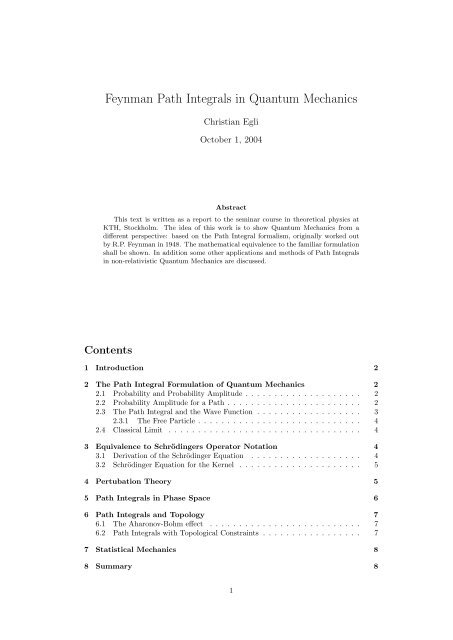
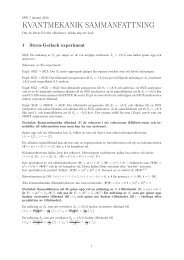

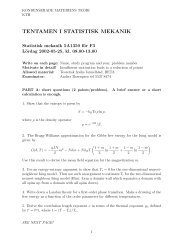
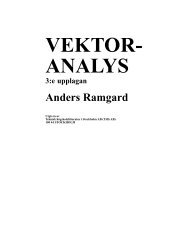
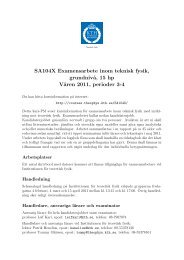

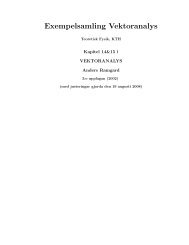

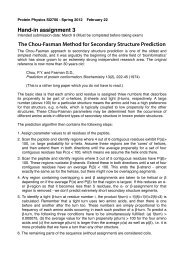

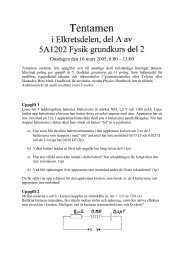
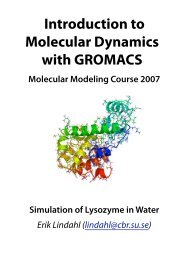
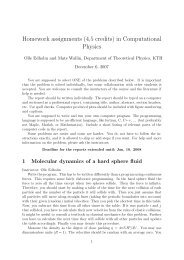
![[VAR]=Notes on variational calculus](https://img.yumpu.com/35639168/1/190x245/varnotes-on-variational-calculus.jpg?quality=85)